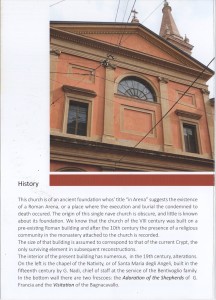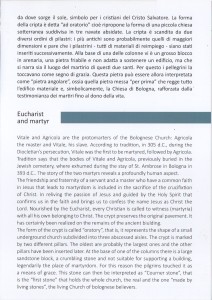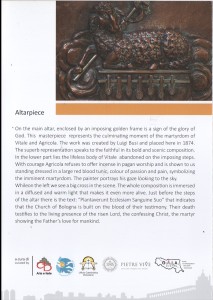Church of Saints Vitale and Agricola in Arena
History
This church is of an ancient foundation whos’ title “in Arena” suggests the existence of a Roman Arena, or a place where the execution and burial the condemned to death occurred. The origin of this single nave church is obscure, and little is known about its foundation. We know that the church of the VIII century was built on a pre-existing Roman building and after the. 10th century the presence of a religious, community in the monastery attached to the church is recorded.
The size of that building is assumed to correspond to that of the current Crypt, the only surviving element in subsequent reconstructions.
The interior of the present building has numerous, in the 19th century, alterations. On the left is the chapel of the Nativity, or of Santa Maria degli Angeli, built in the fifteenth century by G. Nadi, chief of staff at the service of the Bentivoglio family. In the bottom wall there are two frescoes: the Adoration of the Shepherds of G. Francia and the Visitation of the Bagnacavallo.
————-
Eucharist and martyr
Vitale and Agricola are the protomartyrs of the Bolognese Church: Agricola the master and Vitale, his slave. According to tradition, in 305 d.C., during the Diocletian’s persecution, Vitale was the first to be martyred, followed by Agricola. Tradition says that the bodies of Vitale and Agricola, previously buried in the Jewish cemetery, where exhumed during the stay of St. Ambrose in Bologna in 393 d.C.. The story of the two martyrs reveals a profoundly human aspect.
The friendship and fraternity of a servant and a master who have a common faith in Jesus that leads to martyrdom is included in the sacrifice of the crucifixion of Christ. In reliving the passion of Jesus and guided by the Holy Spirit that confirms us in the faith and brings us to confess the name Jesus as Christ the Lord. Nourished by the Eucharist, every Christian is called to witness (martyria) with all his own belonging to Christ. The crypt preserves the original pavement. It has certainly been realized on the remains of the ancient building. The form of the crypt is called “oratory”, that is, it represents the shape of a small underground church subdivided into three abscessed aisles. The crypt is marked by two different pillars. The oldest are probably the largest ones and the other pillars have been inserted later. At the base of one of the columns there is a large sandstone block, a crumbling stone and not suitable for supporting a building legendarily the place of martyrdom. For this reason the pilgrims touched it as a means of grace. This stone can then be interpreted as “Corner stone”, that is the “first stone” that holds the whole church, the real and the one “made by living stones”, the living Church of bolognese believers.
———



